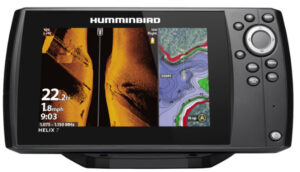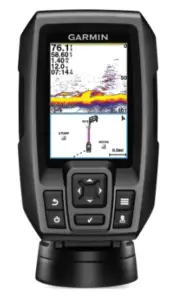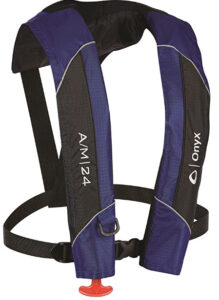How To Fish Canyon Lake

Canyon Lake is a moderate sized desert reservoir that sits between it’s sister reservior Saguaro Lake and Apache Lake in central Arizona. Overall it’s a relatively quiet lake. In this post you’re going to be given the blueprint to fish this lake.
So what are the best tips for fishing Canyon Lake? There are three important factors you must know if you want to know how to fish Canyon Lake successfully. First, you need to know what kind of fish is in Canyon Lake. Second, it’s important for you to know which part of the lake each species can be found. Lastly, knowing what are the best baits that work on Canyon Lake is vital. However, tactics, baits, and locations will be different for each type of fish that you target. So let’s talk about the steps you need to take in order to give you the best chance of catching a fish on Canyon Lake.
Key Takeaways
This lake gives locals and visitors the opportunity to test their luck in catching one of the many game species this lake has to offer, such as Largemouth Bass, Smallmouth Bass, Yellow Bass, Channel Catfish, Bluegill, and much, much more!
Here’s the most recent and updated Canyon Lake Fishing Report – it gives you a quick and easy list of some really good fishing spots. If you’re looking for more detail on how to fish each spot scroll down into the article.
- La Barge Cove
- Palo Verde & Acacia Recreation Areas
- Salt River Channel Between El Capitan Head and Teddy Bear Hill
- Fallacy Cove and Fallacy Cove Point
- Aspen Point
- Bass Creek & Cut-Out Cove
- Moonbeam Straight & Moonshine Point
- Lost Dutchman Bay
- Skull Cove
Here are some additional fast and helpful tips just for you:
- The easiest way to fish this lake is by boat, but there are areas to fish from the bank, by kayak, or float tube.
- There are multiple public boat ramps to use.
- Camping and RV parking is available.
- You can buy tackle and groceries at the lake or at one of the tackle shops in Phoenix.
- A permit is required to enter, camp, and fish this lake. Prices vary depending on your desired activity.
About Canyon Lake
Located just outside of east Phoenix, Canyon Lake is a deep body of water with an average depth being 130 feet and a maximum depth of 141 feet when the lake is completely full. Being 10 miles long and spans over 950 acres. This is a reservoir within the Salt River chain lakes and plays a vital role in power generation agriculture. Anglers can fish in a variety of locations from grass mats, river channel drops-offs, rock piles, cuts, and points. Known for its great largemouth bass, yellow bass, and catfishing. You can also see wildlife such as bald eagles and bighorn sheep.
What Kind of Fish Are In Canyon Lake?
- Largemouth Bass
- Smallmouth Bass
- Rainbow Trout
- Yellow Bass
- Black Crappie
- Walleye
- Carp
- Bigmouth Buffalo Fish
- Channel Catfish
- Flathead Catfish
- Bluegill
- Green Sunfish
- Redear Sunfish
- Tilapia
My personal fishing report update:
Alright, my fishing friends, let’s dive into the current scene on the water.
Lately, the wind’s been tossing us a curveball, making our quest for that trophy a bit more of an adventure.
But, as any savvy angler knows, those breezy conditions can’t keep a good fisherman down. In fact, some folks are absolutely slaying it with largemouth and striped bass during those calm windows between weather fronts.
So, here’s the lowdown: those northern coves are still where the party’s at, although our bass buddies are doing a bit of a dance—moving in and out depending on whether they’re cozying up on their beds.
Some anglers have been hitting the shallows, about 4 feet deep, with a trusty drop shot setup and have been hooking into some beauties. Then, shifting gears and going deeper, they bagged a chunky 6-pounder. Tallying up, they netted themselves 15 to 20 largemouths, most tipping the scales between 1 and 2.5 pounds.
And get this, the bass are in full-on love mode in the shallows at the back of the coves, while the post-spawn crowd is hanging out off the points, islands, and reefs. The numbers might not be blockbuster yet, but patience is key.
Helpful tip: anything white will be like bass candy right now— jerkbaits, crankbaits, you name it.
For the lure lovers here’s a list of what is working right now:
- Topwaters
- Swimbaits
- Umbrella rigs
- Jerkbaits
- Football jigs
- Crankbaits
- Drop shot
- Texas rig worm or creature baits
- Carolina rig
Guys, the northern hideouts where the bass are busy spawning and can be easily caught.
I got talking to a guy loading his kayak who fished from mid-morning to afternoon and landed two largemouths on drop shots.
So there you have it, my angling amigos…
The fish are out there, dancing with the elements, and it’s up to us to join the party. Keep those lines tight and your spirits high, and remember, every day on the water is a good day.
Key Details to Know About Canyon Lake
Special Closures Areas or Dates:
Periodic closures due to wildfires. Check the status of the lake to see if it’s open, click here.
Per AZGFD, “On most weekends and holidays April – October, Canyon Lake reaches its maximum boating capacity early in the day, and no additional boats are allowed in. Be prepared for delays in boat access during summer weekends“
Special /Annual Events:
Weekend fishing tournaments are common.
Canyon Marina offers food, bar, live music, karaoke, and annual watch parties for all the big sporting events and tournaments (ie; March Madness, Superbowl, World Series), and much, much more.
Canyon Lake Fishing Tips & General Strategies
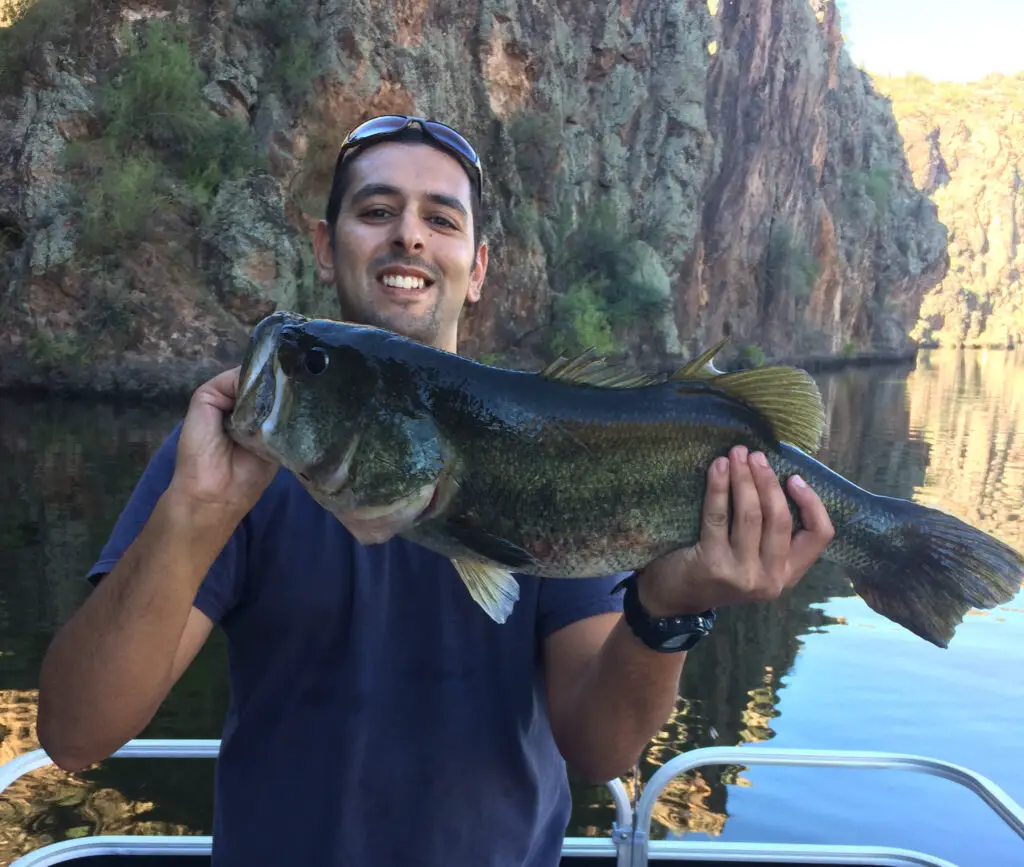
photo: AZGFD
Canyon Lake is one of the most beautiful lakes Arizona has to offer.
It’s stocked with bass, bluegill, crappie, catfish, and even some holdover trout.
This lake is best fished from a boat, however, there is plenty of shoreline angles can enjoy from La Barge Cove to the Acacia Picnic Area
Most of the fish here will spawn in the spring in 1-15-feet of water notably on rocky structures, gravel flats, humps, and small creek inlets and cuts.
This lake is loaded with rocky points, cuts, pockets, feeder creeks, bluff walls, and submerged ledges.
The areas where you will have the most consistent success are large rocky structures whose north-facing sides are shaded.
In the summer bass will seek deeper ledges and shelves in 8-15-feet of water.
If you find any floating debris, mats, vegetation anywhere in this lake is sure to stop and fish it. These mats make an artificial shaded area that bass and other fish will hide under.
If you’re a bass angler who’s wanting to catch a giant bass, fishing a large swimbait at one of these locations during a stocking session can land you a massive size bass.
Canyon [lake] can be one of the most challenging lakes to fish. But once you know what the fish are biting, you probably catch your personal best in this lake!
Paul Tanner
At Canyon Lake, trout are stocked at the main boat ramp and in LaBarge Cove.
Trout will hold in less than 10 feet of water during the late winter and early spring. Whereas, during the summer they will be found suspended in over 20-40-feet of water.
Trout can grow to be huge here due to the lake being receiving less fishing pressure than the other closer lakes. This lake is also really deep and colder than the other lakes which the trout like.
By now you should know that Canyon can be a great bass fishing lake and can hold some massive lake trout, but it’s an excellent lake for catfishing, yellow bass, and walleye fishing as well.
If you’re fishing from the shore you can fish around the docks or near the fishing platforms by the second ramp.
Personally, I like to fish for the big bass in the morning and in the afternoon troll deeper cuts and shelves with spinners to catch some fat lake trout for dinner.
General Tips Before You Fish The Canyon Section At Canyon Lake...
Fishing the canyon section of Canyon Lake can seem a little overwhelming.
Parts of Canyon Lake have long sections of breathtaking bluff walls. Fishing those towering walls can be very rewarding. Depending on the current and time of day it’s worth checking out certain sections of these walls.
Before you fish, scan the walls for submerged structures such as fallen boulders, shelves, and drop-offs on both sides.
First, find out what direction the current is going. Central Arizona Project (CAP) will either dump water or pull water to pump into or out of the lake. This creates a current on the lake.
Second, determine how strong the current is.
Strong pulling current will force fish away from the inside bends (unless there are large submerged structures like a large boulder, that will break up the current and the fish will hide behind). The fish won’t move far but will move to the opposite side of the river just downriver to the outside bend.
The slower current will draw the bass out and will hang out along the inside bends of the bluff wall.
Unless you’re flipping baits in a small spot on the bluff wall, it’s recommended to cast your bait upstream. Predator fish like bass and walleye will orientate themselves facing upstream.
As a rule of thumb:
- The north-facing sections of the canyon will hold the most fish and will be the most productive.
- If the current is fast, fish the points, large structures/boulders, shelves.
- If the current is slow, fish the inside bends and always have a topwater bait or frog tied on.
- If you’re fishing after a recent rainstorm fish the small feeder coves/cuts can produce a ton a bass.
- Fishing in the spring, bass will often spawn on the south-facing shoreline.
- Fishing the shadow line in the morning can also be very productive.
- You’ll most likely have the best luck with jigs, crankbaits, spinnerbaits, underspins, swimbaits, tubes, drop shot baits, and senkos-like lures.
But Where Are The Best Places To Fish At Canyon Lake?
And in no particular order here is that list of the best fishing spots at Canyon Lake.
DISCLAIMER: The material provided is for general information purposes only. It’s important to understand that any information provided in this article can change at any time. Any maps or graphics featured are not to be used as navigational aids. Fishing Blueprint will not be responsible for any personal injury or property damage from any misuse of the maps or graphics provided. It’s completely impossible to give you every single spot where you can potentially catch a fish. But, what this list does do is to give you a helping hand and narrow down to the most productive fishing spots.
La Barge Cove
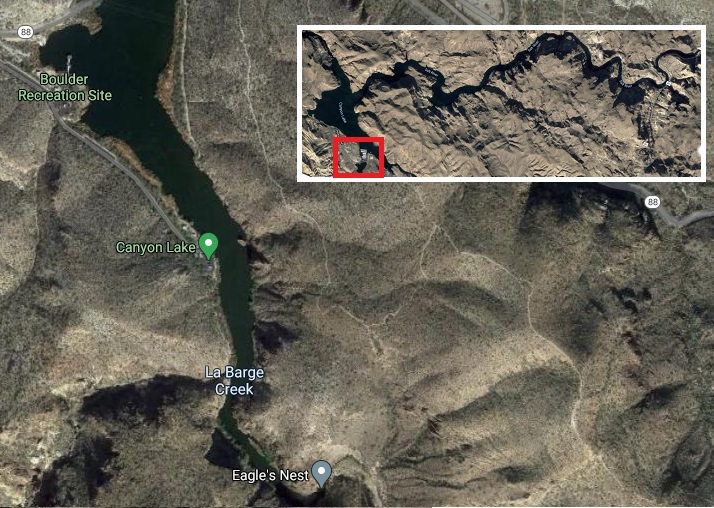
LaBarge Cove is like a small lake attached to the main body of water. The big cove connects to the main lake by a narrow channel that goes under the highway adjacent to the marina.
Scan this area with a portable fish finder if you’re fishing from the pier because of the large amount of artificial habitat placed around this area.
Fish around the habitat or structure if you see shad or bluegill in the area.
So make sure you pick up a portable fish-finder to find all the best fishing spots.
Yellow bass will hold in school at the mouth of the cove.
Effective baits for this area include: topwater lures, buzzbaits, frog lures, crankbaits, soft plastic swimbaits, spinnerbaits, jerkbaits, chatterbaits, swim jigs, hair jigs, and underspin jigs when the bass are aggressive. Flutter spoons work great in the deeper channel sections and above any vertical timber as well.
If the bass are timid, then drop shot, tubes, Ned rig, Neko rig, Mojo rig, Carolina rig, and football jigs all work really well.
Located: West lake, just west of the Canyon Lake Marina
Structural features: Shoreline fishing, artificial submerged structure, artificial habitat, roadbed.
Best species to target: Bass, yellow bass, crappie, and catfish
Most effective way to fish this spot: Boat, kayak, shoreline
Palo Verde & Acacia Recreation Areas
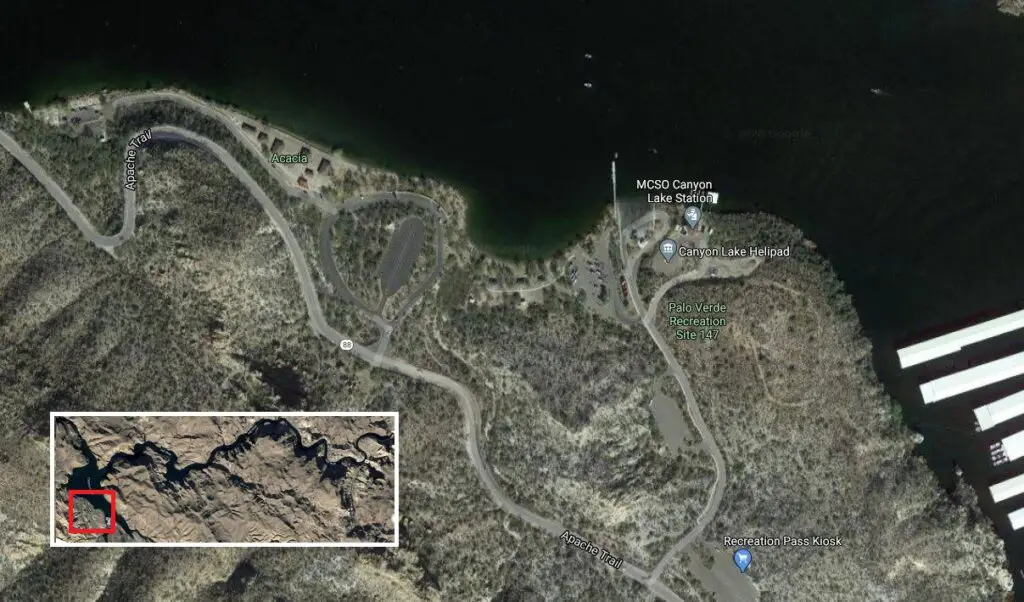
The shorelines of the Palo Verde Recreation Area and Acacia Recreation Area spans just under 3/4 of a mile!
This shoreline is very easy to walk and fish from. It has chalked filled with submerged artificial habitat structures. Again, this where you need a portable fish-finder!
It’s great for beginners and for seasoned anglers who don’t want to take the boat out but still want to have a great time.
Effective baits for this area include: topwater lures, buzzbaits, frog lures, crankbaits, soft plastic swimbaits, spinnerbaits, jerkbaits, chatterbaits, swim jigs, hair jigs, and underspin jigs when the bass are aggressive. Flutter spoons work great in the deeper channel sections.
If the bass are timid, then drop shot, tubes, Ned rig, Neko rig, Mojo rig, Carolina rig, and football jigs all work really well.
Located: west-lake/ just west of the Canyon Lake Marina
Structural features: Cuts, natural and artificial submerged structure.
Best species to target: Bluegill, yellow bass, bass, and catfish
Most effective way to fish this spot: Shoreline, kayak, float tube, boat.
Salt River Channel Between El Capitan Head and Teddy Bear Hill
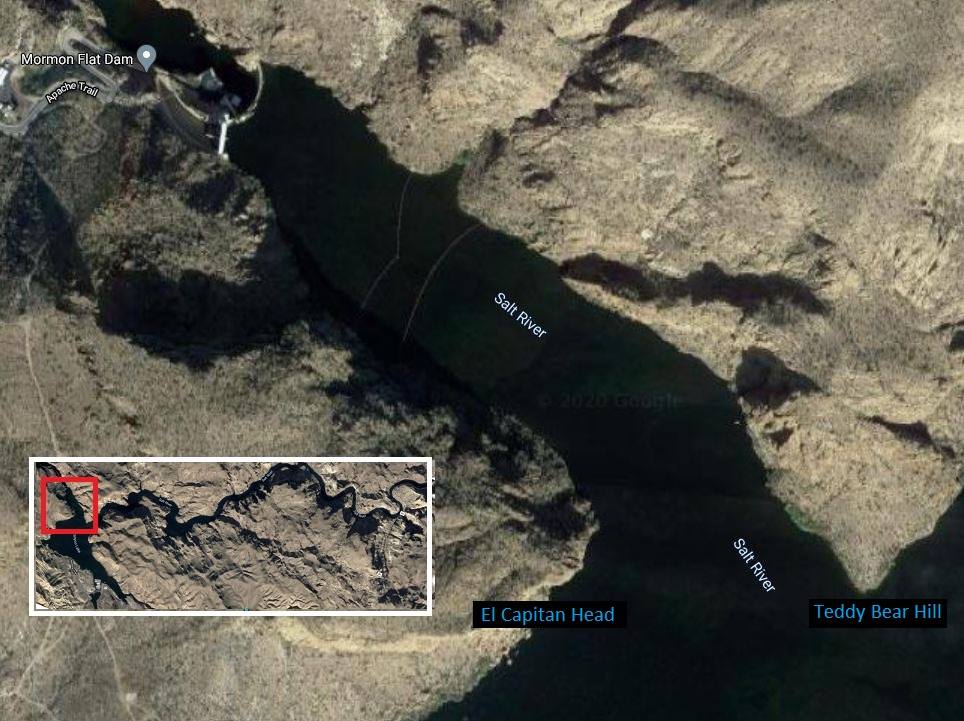
This stretch of mid-lake river channel is a very deep section of the lake and can be an excellent place to troll for lake trout.
Graph this area from the “mouth” (section of water between El Capitan and Teddy Bear Hill) all the way to the barrier just before the Mormon Flat Dam to see what depth the trout are holding at. Then you can easily adjust your lure depth to just above the suspending depth.
This section of the lake can get very windy. And even with the best trolling motor the wind can quickly blow you off your spot which will significantly decrease your chances of catching a fish..
That is why we strongly suggest buying a quality drift sock. For those who don’t know, a drift sock is like a parachute for the water. If it’s breezy to windy, you need to slow your drift otherwise your lure will not be in the strike zone long enough to catch a fish.
By the way, we found a really good quality drift sock made by Mythik Outdoors, and best of all they’re sold on Amazon.com. Go here to learn more about drift socks and read the reviews from actual customers.
Some of the effective baits for this area include:
But wait! Before you tie on any bait nearly every professional fishing guide will strongly encourage the use of a fish attractor like a quality flasher or dodger 2-3 feet in front of any lure. This helps get the fish’s attention, kinda like ringing a dinner bell!
Trolling spoons such as a Krocodile spoon, Super Duper, Crippled Herring, Cast Champ, or Hus-Lure. Trolling spoons have an unpredictable, minnow-like motion that delivers bone-crushing strikes. Even the slowest current brings these lures to life. Add extra motion by twitching the rod tip and enabling the bait to pop and dart forward and flutter back.
Inline spinners such as the Bang-Tail and Shyster are non-twist spinners that boast an immediate spin blade design for incredibly rapid start-ups and the best slow retrieve performance.
Many anglers also place their confidence in the Blue Fox Classic Vibrax inline spinner. This little bait is a compact shallow running lure that performs best in 2 to 6 feet of water, depending on the speed of the retrieve or trolling speed. The patented two-part body emits low-frequency sound vibrations that attract fish. This lure is best used in lakes, rivers, and streams.
Minnow style baits also work very well either cast-and-retrieved or trolled. These perform best if the water is clear/slightly stained. The Luhr-Jensen Quick Fish and the Rapala BX minnow are constructed from hard plastic, have a wide wobble action, and are extremely durable. Whereas the Rapala Original Floating Minnow and the Ultra Light Minnow (all are slow sinking) both give you a tighter wobble perfect for clear water and pressured fishing conditions.
Better yet, just buy a complete done-for-you trout lure kit!
Now if you’re fishing from the shore, kayak, or even from the shore you should also consider using these additional baits:
- Real or artificial corn – great because it will never spoil or mold over
- Natural salmon eggs – it’s hard to beat natural salmon eggs when trout are eating salmon eggs, they’ll eat up jars of this stuff!
- Artificial salmon eggs – great because they float off the bottom – ideal in rocky or grassy conditions
- Real worms – such as meal worms or nightcrawlers
- Artificial worms – great for trolling and will never die)
- Dough bait – great because they stay on the hook really well, it floats if you put enough on the hook, come in a variety of colors and scents.
Oh, before I forget, did you know that there is an article about how to troll for salmon, trout, and kokanee the right way? Go here to find out more.
Oh, before I forget, did you know that there is an article about how to troll for trout the right way? Go here to find out more.
If you’re fishing from the shore during the summer anywhere in this area I would strongly recommend it.
Smallmouth bass and bluegill prefer to live close to the rocks. Smallmouth bass can be caught using smaller crankbaits, soft plastic swimbaits, and drop shot.
Bluegill can be caught with a simple bobber and small #12 hooks with a bread ball, corn, or even a small piece of Slim Jim (don’t laugh, it works).
Located: West-lake, river channel
Structural features: Steep rocky banks, deep channel
Best species to target: Trout (mid-lake, summer). Bass, yellow bass, crappie, trout (early spring)
Most effective way to fish this spot: Boat
Fallacy Cove and Fallacy Cove Point
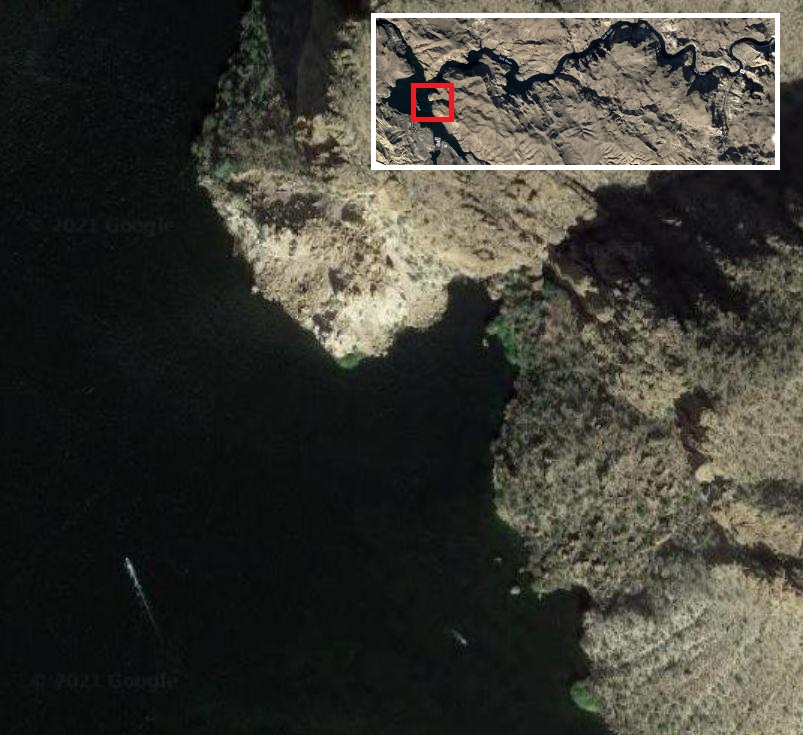
Fallacy Cove is a great main lake spot if you rather not travel all the way upriver to find some good bass fishing.
It has mostly rocky structure and has a minimal amount of submerged brush. It’s a good fishing spot to check out because it offers a large number of nearby drop-offs, points, and flats that extend into the main lake.
To the north of Fallacy Cove sits Fallacy Cove Point which is a large main-lake point. Excellent for bass during the summer and trout and yellow bass will suspend over this spot as well.
Effective baits for this area include: topwater lures, buzzbaits, crankbaits, soft plastic swimbaits, spinnerbaits, jerkbaits, chatterbaits, swim jigs, hair jigs, and underspin jigs when the bass are aggressive.
If the bass are timid, then drop shot, tubes, Ned rig, Neko rig, Mojo rig, Carolina rig, and football jigs all work really well.
Located: Mid-lake, north side
Structural features: Rocky structure, minimal brush, drop-offs, points
Best species to target: Bass, yellow bass, crappie, bream, trout
Most effective way to fish this spot: Boat
Aspen Point

Aspen Cove is not really a cove, but rather a north-facing outside bend of the Salt River channel. This section of the canyon is filled with a ton of cuts, washes, boulders, and underwater structures.
Naturally, crawfish, bluegill, minnows, and shad seek shelter in this area.
Given this embankment’s large area, it’s best to focus your efforts on cuts, points, boulder piles, and on transition areas from larger rock to smaller rock size.
Effective baits for this area include: topwater lures, buzzbaits, crankbaits, spinnerbaits, umbrella rigs, chatterbaits, jerkbaits, underspin jigs, swim jigs, hair jigs, and soft plastic swimbaits perform well here in breezy conditions.
In contrast, slower moving baits such as drop shot, football jigs, tubes, wacky rig, Texas rig, Neko rigs, and Carolina rigs can be phenomenal when the conditions are calm or the bass are holding close to the rocks.
Located: west-lake
Structural features: Cuts, natural and artificial submerged structure, artificial habitat, roadbed.
Best species to target: Bass and catfish
Most effective way to fish this spot: Boat, kayak, shoreline
Bass Creek (left) & Cut-Out Cove (right)

During the summer when the water is high portions of these coves this area turns into a floating vegetation mat. These small areas are great to fish after a summer thunderstorm passes through.
The river channel will often harbor bass, crappie, yellow bass, and catfish that retreat away from the midday heat can be fished a similar way.
Effective baits for this area include: For floating vegetation mats go with a frog lure, flipping lure, heavy vegetation punching bait, or a Texas rigged Senko.
For vertical emergent vegetation such as tall tulles/cattails or patches of thin twig-like reeds, you can use a frog lure, flipping lure, heavy vegetation punching bait. If it’s breezing and you’re fishing emergent vertical vegetation, consider switching to a spinnerbait, swim jig, or chatterbait.
Fish the weedline edges parallel with crankbaits, lipless crankbaits, spinnerbaits, frog lures, soft plastic swimbaits, umbrella rigs, swim jigs, underspin jigs or chatterbaits.
Located: mid-lake, within the canyon
Structural features: Bluff walls, cuts, natural and artificial submerged structure
Best species to target: Bass, yellow bass, crappie, and catfish
Most effective way to fish this spot: Boat
Moonbeam Straight & Moonshine Point (right)
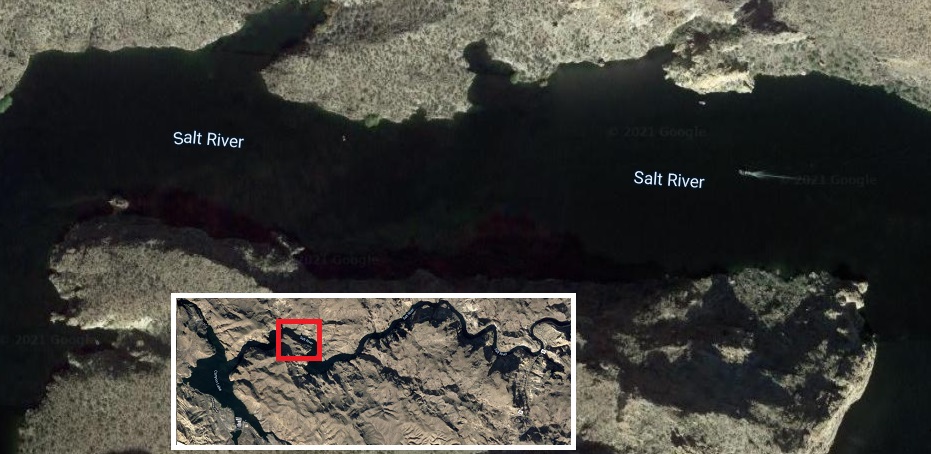
Moonbeam Straight is the north-facing section of the river. This area is loaded with pockets, cuts, boulders, drop-offs, and ledges. Moonshine Point is an excellent place to fish when the current is moderate to strong.
Trout can also be found suspended over the main river channel in this area.
Be sure to target the areas that are shaded first when targeting bass.
The river channel will often harbor bass, crappie, yellow bass, and catfish that retreat away from the midday heat can be fished in a similar way.
Effective baits for this area include: crankbaits, soft plastic swimbaits, spinnerbaits, jerkbaits, chatterbaits, swim jigs, hair jigs, and underspin jigs when the bass are aggressive. Flutter spoons work great in the deeper channel ledges as well.
If the bass are timid, then drop shot, tubes, Ned rig, Neko rig, Mojo rig, Carolina rig, and jigs all work really well.
Located: mid-lake, within the canyon
Structural features: Bluff walls, cuts, natural and artificial submerged structure
Best species to target: Bass, yellow bass, crappie, and catfish
Most effective way to fish this spot: Boat
Lost Dutchman Bay
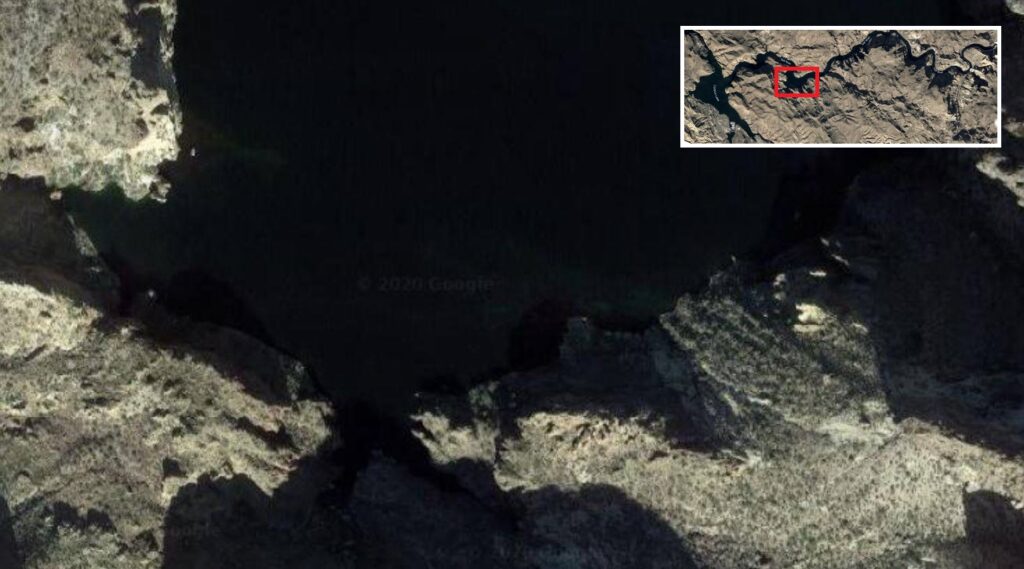
During the summer this spot is excellent when the water has a slow current.
It can be highly productive with topwater poppers, walking baits, and buzzbaits.
In the afternoon, bass hold close to the shoreline. The shoreline is inundated with rocky banks, boulders, and ledges. Baits should be flipped between gaps and crawled over boulders in the shadow-line.
The river channel will often harbor bass, crappie, yellow bass, and catfish that retreat away from the midday heat can be fished in a similar way.
Effective baits for this area include: crankbaits, soft plastic swimbaits, spinnerbaits, jerkbaits, chatterbaits, swim jigs, hair jigs, and underspin jigs when the bass are aggressive. Flutter spoons work great in the deeper channel ledges as well.
If the bass are timid, then drop shot, tubes, Ned rig, Neko rig, Mojo rig, Carolina rig, and jigs all work really well.
Located: mid-lake
Structural features: Bluff walls, cuts, natural and artificial submerged structure
Best species to target: Bass, yellow bass, crappie, and catfish
Most effective way to fish this spot: Boat, kayak
Skull Cove
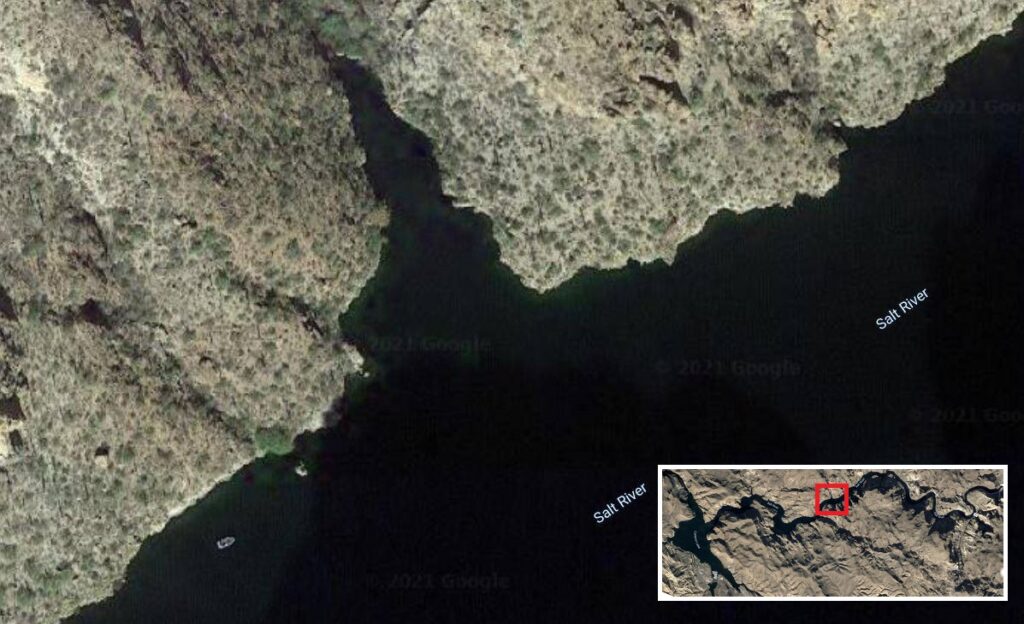
Even though Skull Cove is a southern facing cut, it’s an excellent spot to target after a thunderstorm as passed through.
Look for waterfalls around this area.
Once you spot a waterfall, fish it using crankbaits, soft plastic swimbaits, spinnerbaits, jerkbaits, chatterbaits, swim jigs, hair jigs, and underspin jigs.
This area has a significant drop-off to the main river channel.
Similarly, weedless topwater lures such as frog lures and buzzbaits work very well here.
The river channel can also hold a lot of fish such as crappie, yellow bass, and catfish.
Swimbaits and deep diving crankbaits will work well when fishing the nearby channel.
Located: east-lake
Structural features: small feeder cover next to a channel drop-off. Vegetation, and large rocky submerged structure is also present
Best species to target: Bass, yellow bass, crappie, catfish, and walleye
Most effective way to fish this spot: Boat
How To Catch Fish In Canyon Lake?
Largemouth Bass Fishing at Canyon Lake
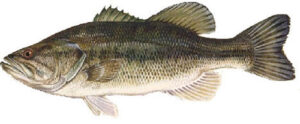 You may be wondering… How do you fish for bass in Apache Lake? The Largemouth bass is a carnivorous member of the sunfish family. Canyon Lake holds the Northern and Florida strain species. The Northern strain is thought to be considered more aggressive and offers a better fight than their Florida strain cousins. Whereas, the Florida strain can grow to an enormous size.
You may be wondering… How do you fish for bass in Apache Lake? The Largemouth bass is a carnivorous member of the sunfish family. Canyon Lake holds the Northern and Florida strain species. The Northern strain is thought to be considered more aggressive and offers a better fight than their Florida strain cousins. Whereas, the Florida strain can grow to an enormous size.
Listed below are a handful of facts, top spots, and best lures to use to help you out…
If you’re still not sure how to catch a bass, do worry. A complete section on Bass Fishing 101 was written to help you out. In that section, you’ll learn about the top ways to get you catching bass fast.
Read more: Beginner’s Guide To Bass Fishing Basics – Tips, Secrets & Things To Avoid
General Largemouth Bass Details
Spawn: Spring, March-May
Food: Shad, bluegill, crayfish
Arizona State Record: 16 lb. 7.68 oz. 28.0 in., Canyon Lake Randall E. White, Mesa 4/22/97
Table Quality: Decent. Firm white meat.
Angling techniques:
Smallmouth Bass Fishing at Canyon Lake
 Smallmouth bass are sibling species closely related to largemouth bass. They have a pretty brown/golden color and carry the nickname of “bronzeback”. Some physical features make it different from the largemouth bass. Aside from being bronze in color, they will have grey-brown vertical bands and most definingly is the jaw does not extend past its eye.
Smallmouth bass are sibling species closely related to largemouth bass. They have a pretty brown/golden color and carry the nickname of “bronzeback”. Some physical features make it different from the largemouth bass. Aside from being bronze in color, they will have grey-brown vertical bands and most definingly is the jaw does not extend past its eye.
Overall, smallmouth bass are most likely going about half the size of largemouth bass. However, pound for pound, a smallmouth can be increadably aggressive and will put up an amazing fight.
General Smallmouth Bass Details
Spawn: March-May
Food: fish, crustaceans.
Arizona State Record: 6 lb. 4.48 oz. 21 in. Lake Havasu Sue Nowak, 2/23/17
Table Quality: Similar to a largemouth bass it’s firm, white, flaky, mild-tasting
Angling techniques:
- Finesse jigs
- Mojo Rig
- Neko Rig
- Small crankbaits
- Football Jigs
- Soft plastic swimbaits
- Jerkbaits
- Chatterbaits
- Swim jigs
- Hair jigs
- Underspin jigs
- Drop shot plastic worms
- Tubes
- Streamer flies
- Live baits: minnows, hellgrammites, and crayfish
Trout Fishing at Canyon Lake
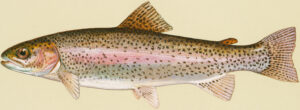 Arizona Game & Fish Department grow and stocks local lakes and reservoirs like Canyon Lake with Rainbow Trout.
Arizona Game & Fish Department grow and stocks local lakes and reservoirs like Canyon Lake with Rainbow Trout.
Due to this lake being relatively unpressured, deep, and colder, and most other desert reservoirs, the stocked trout do very well.
Since the trout are produced in local fisheries, they are healthy and have no limit on the amount of trout that can be consumed.
Typically trout are stocked twice a week, however, it can vary.
General Trout Details
Spawn: March-May
Food: insects and crustaceans.
Arizona State Record: 15 lb. 9.12 oz. 32.5 in., Willow Springs Lake Harold Wright, Sun City 9/29/06
Table Quality: Depending on the fishes diet, the meat can be white to orange-red in color. The meat is firm, flaky, and is considered excellent eating.
Angling techniques:
- Trolling with or without downriggers
- Trolling flies
- Worms
- Salmon eggs
- Powerbait
- Corn
- Cheese
- Marshmallows
- Spinners
- Spoons
- Flies
- *The number one key to successful trout fishing, is to use light line (2 to 6 pound) and small hooks (10-14 sizes), and small sinkers
Yellow Bass Fishing at Canyon Lake
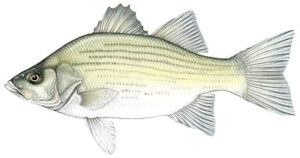 Introduced in 1930 the yellow bass have 4 to 7 dark horizontal lines and are yellow-golden color which is more pronounced over the spine of the fish. They are also a member of the “true bass” family.
Introduced in 1930 the yellow bass have 4 to 7 dark horizontal lines and are yellow-golden color which is more pronounced over the spine of the fish. They are also a member of the “true bass” family.
Ferocious eaters, the yellow bass hunt in schools pursuing schools of threadfin shad. Like some other bass species, yellow bass will also corral the shad near the surface and cause the shad to jump out of the water called a “shad boil”.
This lake has an ample amount of Yellow bass, best of all they’re really easy to catch.
If you are in relatively open water and find a school of shad of your sonar, chances are Yellow bass are close by.
If the Yellow bass bite slows don’t be too quick to find another spot, just back off and scan the area around the shad and find that same school.
Most of the time yellow bass will position and hold closer to any bottom structure more so than the white bass.
If you’re using jigs, spoons or worms, simply flip you bait adjacently or straight through the school of Yellow bass.
Watch your line as it’s falling if it stops mid-fall it means a Yellow bass ate your bait – set the hook!
After you let your bait fall to the bottom raise your rod tip up just a bit. If it feels mushy, it also means a Yellow bass ate your bait – set the hook!
Spawn: March to May
Food: Threadfin shad, other smaller minnows, and fish, insects.
Arizona State Record: 2 lbs. 2.56 oz. 14.25 in., Canyon Lake Ron Johnson, 2/7/20
Table Quality: The meat is excellent. It’s firm, flaky, and white. There is a red lateral line that must be removed otherwise it gives off a strong “fishy” taste. Otherwise, these make excellent fish fry meals.
Angling techniques:
- Spinners
- Spoons
- Small soft plastic swimbaits
- Small lipless crankbaits
- Small topwater poppers and pencil baits
- Hook and worm under a bobber
Black Crappie Fishing at Canyon Lake
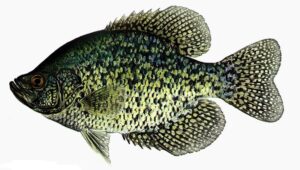 Introduced to Arizona in 1905, Canyon Lake holds black crappie. These fish tend to linger over submerged brush and timber and are found in schools.
Introduced to Arizona in 1905, Canyon Lake holds black crappie. These fish tend to linger over submerged brush and timber and are found in schools.
The black crappie are much more tolerant in cooler water than their white crappie cousins.
Black crappie can be described as having an irregular black dots and blotched on the back and have more of a “silvery-olive” background.
Average weight of a crappie in Canyon Lake is going to be 0.75-pounds, however electro-netted samples show they can get over 3-pounds in size!
The best time to fish for crappie in this lake and other lakes similar to it is in summertime while you’re night using a submerged green light. If you don’t know what a green fishing light is, or if you’re unfamiliar, then click this link to learn more.
General Crappie Details
Spawn: April – mid-June
Food: Larvae, small fish, and crustaceans. Threadfin shad make up their main diet.
Arizona State Record: 4 lb. 10.0 oz. –in., San Carlos Lake John Shadrick, Mammoth 1959
Table Quality: The meat is excellent. It’s firm, flaky and white.
Angling techniques:
- Live minnows under bobbers
- Crappie jigs
- Crappie tubes
- Silver spoons
- Spinners
Walleye Fishing at Canyon Lake
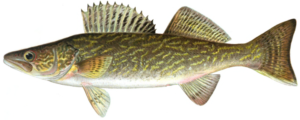 Introduced to Arizona in 1957, Canyon Lake holds good size walleye.
Introduced to Arizona in 1957, Canyon Lake holds good size walleye.
The average size of a walleye in Arizona will be 1-3-pounds. Some can grow up to 12-pounds and live to nearly 30-years old!
Walleyes have huge eyes which are sensitive to light, so they are usually located near the lake’s bottom, deep channels, and ledges.
These are tasty predators and during the spring spawn they can be found in shallow water, warmer water.
For walleye deep diving crankbaits and inline spinners that imitate baitfish species are a tried and true method.
If you find deep, rocky sections and baitfish nearby, jigging a large spoon will occasionally catch fish as well.
Night fishing for walleyes gives you the best chance to catch one due to their general sensitivity to light.
Make sure to add glass beads above your spinner to make sound, as well as to tip the tip with a juicy nightcrawler with some bait scent for added attraction.
Finally, switch it up to a rattling crankbait if you’re not getting any bites.
General Walleye Details
Spawn: March-May
Food: Baitfish, crayfish, and worms. Threadfin shad make up their main diet.
Arizona State Record: 16 lb. 1.76 oz. 31 in., Show Low Lake. Gregg Munck, Show Low 11/18/02
Table Quality: The meat is excellent. It’s firm, flaky and white.
Angling techniques:
- Because of light-sensitive eyes, walleyes feed more actively early in the morning, late in the evening, or at night.
- Trolling or drifting minnows, nightcrawlers, and spinners
- Jointed minnow plugs (silver-black Rapalas)
- Deep diving crankbaits
- Spoons
- Inline spinners
Catfish Fishing at Canyon Lake
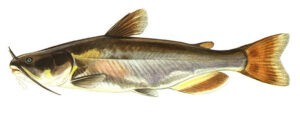
Channel catfish weight will range from 0.5-to-15-pounds in and of the Roosevelt chain lakes, including Canyon Lake. However, the average weight will be between 1-4-pounds.
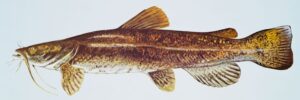
Conversely, “smaller” flathead catfish will weigh in at 15-pounds and can grow around 75-pounds. A flathead survey conducted in 2016 and 2020 caught a flathead that weighed over 48-pounds!
General Catfish Details
Spawn: March-June
Food: Carp, bluegill
Arizona State Record:
Channel catfish – 33 lb., 5.76 oz., 39.5 in., Upper Lake Mary Carson Pete, 3/26/17
Flathead catfish – 76 lb. 8.64 oz., 53.5 in., Bartlett Lake Eddie Wilcoxson, Surprise 04/13/13
Table Quality: Soft white meat. In the summer the meat will taste muddy.
Angling techniques:
Flathead catfish:
- live bait such as smaller carp, full sized bluegill, or tilapia
Channel catfish:
- chicken liver
- hotdogs
- stink bait
- small bluegill
- small carp
Bluegill Fishing at Canyon Lake
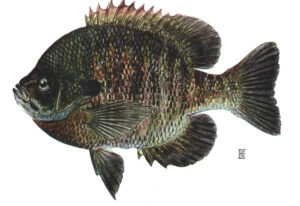 Introduced to Arizona in 1932, the bluegill has teal-blue coloring on the bottom portion of the chin and gill plate. It also has a solid black opercula flap just behind the gill plate.
Introduced to Arizona in 1932, the bluegill has teal-blue coloring on the bottom portion of the chin and gill plate. It also has a solid black opercula flap just behind the gill plate.
Bluegill are found on the shoreline and prefer nearby structures. Bluegill are incredibly aggressive and will quickly attack anything that looks like it could be eaten. Due to their aggressive behavior, they are one of the easiest fish to catch and are a great way to introduce someone to fishing.
Spawn: April and May
Food: Small fish and insects
Arizona State Record: 3 lb. 15.68 oz. 15.75 in., Goldwater Lake. Christopher Ray Mapes, Prescott Valley 5/2/04
Table Quality: Firm, white meat
Angling techniques:
- Worms
- Dough balls
- Slim jim sausages pieces on a small hook (not lying… it really works)
- Small spinners
- Trout flys
Carp Fishing at Canyon Lake
Carp are an oily freshwater species of fish and are native to Europe and Asia. Carp are considered invasive to the United States.
The big, hard fighting fish are really fun to catch. Many anglers will fish for carp at night and bowfishing from the shore or from a boat!
Carp can be consumed however, their muddy taste and boney meat make it one of the least desirable fish to eat.
Spawn: March-June
Food: algae, plant matter, fish eggs, insects, aquatic worms, small crustaceans (snails), and small crayfish
Arizona State Record: 37 lb. 0.0 oz. 40.0 in., Bartlett Lake Jonathan Gardner, Phoenix 8/8/87
Table Quality: Poor. Soft white flesh that is muddy and riddled with bones
Angling techniques:
- Dough balls
- Corn
- Worms
- Cherry tomatoes (not kidding)
- Commercial carp baits
Best Species-Specific Fishing Spots at Canyon Lake
Top Largemouth & Smallmouth Bass Fishing Spots at Canyon Lake
- Fallacy Cove and Fallacy Cove Point
- Aspen Cove
- Moonbeam Straight
- Moonshine Point
- Lost Dutchman Bay
- Skull Cove
- Waterfall Lagoon
- Around Canyon Marina
Top Trout Fishing Spots at Canyon Lake
- El Capitan Head (near the Mormon Flat Dam)
- Teddy Bear Hill
- Fallacy Point to Moonbeam
- Bass Creek
Top Yellow Bass Fishing Spots at Canyon Lake
- La Barge Cove
- Palo Verde & Acacia Recreation Areas
- Fallacy Cove and Fallacy Cove Point
- Aspen Point
- Bass Creek & Cut-Out Cove
- Moonbeam Straight & Moonshine Point
- Lost Dutchman Bay
- Skull Cove
Top Crappie Fishing Spots at Canyon Lake
- Palo Verde & Acacia Recreation Areas
- El Capitan Head (near the Mormon Flat Dam)
- Fallacy Cove and Fallacy Cove Point
- Aspen Cove
- Moonbeam Straight
- Moonshine Point
- Lost Dutchman Bay
- Skull Cove
- Waterfall Lagoon
- Around Canyon Marina
Top Catfish Fishing Spots at Canyon Lake
- Palo Verde & Acacia Recreation Areas
- El Capitan Head (near the Mormon Flat Dam)
- Bass Creek & Cut-Out Cove
- Lost Dutchman Bay
- Skull Cove
- Around Canyon Marina
Top Bream/Bluegill Fishing Spots at Canyon Lake
- La Barge Cove
- Palo Verde & Acacia Recreation Areas
- Fallacy Cove and Fallacy Cove Point
- Aspen Point
- Bass Creek & Cut-Out Cove
- Moonbeam Straight & Moonshine Point
- Lost Dutchman Bay
- Skull Cove
- Around Canyon Marina
Marinas/ Boat Ramps at Canyon Lake
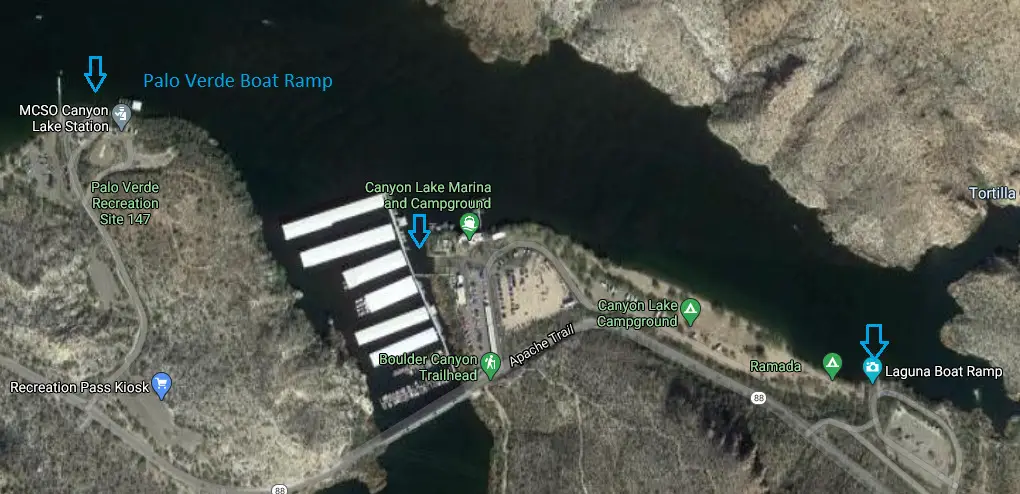
Canyon Lake Marina & Boat Ramp (private)
Address: 14011 N Bush Hwy, Mesa, AZ 85215
Phone number: (480) 986-5546
Groceries/ Snacks: Yes
Bathrooms: Yes
Showers: Yes
Electric: Yes
Gas: Yes
Camping nearby: Yes
Public Boat Ramps Can Be Founds at...
- Laguna Boat Ramp
- Palo Verde Boat Ramp
Places to camp, lodging and RV parks
Traditional camping areas
- Canyon Lake Marina and Campground
- Canyon Lake Marina’s Camp Grounds
Lodging
- None
Boat camping areas (primitive)
- “The Point” campground
RV Hook-Ups (electric & water)
- Tortilla Recreation Area
Tackle Shops & Tackle Retailers Near Canyon Lake
Phoenix Fishing Supply
Located in central Phoenix, Phoenix Fishing Supply has been around since the 1980’s! Even before the big-box stores came into town Phoenix Fishing Supply has been catering to all types of anglers and offers a huge selection of products.
- Address - 4810 North 16th Street, Phoenix, Arizona 85016
- Phone number - (602) 266-2624
- Website - Phoenix Fishing Supply
- Payment methods accepted - Cash, credit, debit
Liar's Korner
Liar’s Korner Fishing Bait & Tackle is nestled in the far east side of metro Phoenix. This tackle shop is proudly run as a small family business that is serious about giving you the right gear to help you catch fish. It doesn’t matter if you’re fishing bass, crappie, walleye, or trout. They have what you need. They carry all the name brands of tackle and gear, and frequently offer better prices than the big-box companies.
- Address - 9529 E Main St, Mesa, AZ 85207
- Phone number - (480) 986-2515
- Website - Liar's Korner facebook page
- Payment methods accepted - Cash, credit, debit
Bass Pro Shops
Located on the east side Phoenix, Bass Pro Shops caters to very type of angler who wants to get their line wet. Founded in 1972 by angler Johnny Morris in Springfield, Missouri Bass Pro Shops combines a massive tackle shop with their hunting, boating, conservation, and guide trips into a comprehensive outdoor and fishing retailer.
- Address - 1133 N Dobson Rd, Mesa, AZ 85201
- Phone number - (602) 606-5600
- Website - Bass Pro Shops
- Payment methods accepted - Cash, credit, debit
Sportsman's Warehouse
Sportsman’s Warehouse feels like a combination of a small outdoor outfitter shop with the capacity to hold a large amount of tackle, gear, and other outdoor accessories. The staff is friendly, patient, and knowledgeable. Sportsman’s Warehouse carries a wide variety of gear for every bass, catfish, trout, crappie, walleye, and pike to get you started.
- Address - 19205 N 27th Ave, Phoenix, AZ 85027
- Phone number - (623) 516-1400
- Website - Sportsman’s Warehouse
- Payment methods accepted - Cash, credit, debit, apple pay
Other Things To Do Near Canyon Lake
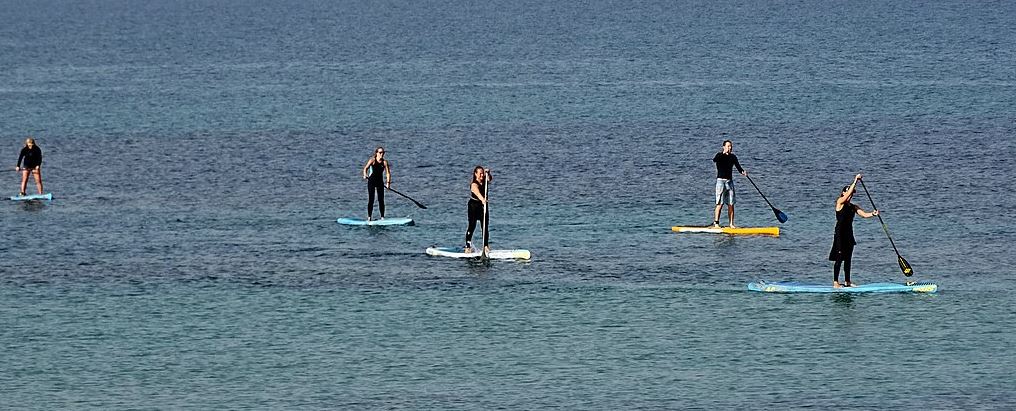
Fishing is not the only thing that brings people to this beautiful body of water. Here’s a list of other things you can do!
- Biking
- Bird watching
- Boating
- Skiing
- Kayaking
- Canoeing
- Paddleboarding
- Sailing
- Swimming
- Camping
- Horseshoes
- Picnicking
- Hiking
- Gentle walking trails
- Nature photography trails
- Wildlife viewing
- Mountain biking
- Stargazing
- and most importantly… relaxing.
Do you need a Tonto Pass for Canyon Lake?
Yes, a Tonto Pass is required if you are going to fish this lake. Luckily there are several types of passes that you can purchase. There are also several different places you can easily purchase a Tonto Pass.
Tonto Pass Options
Tonto Daily Pass – $8
Sold at Tonto National Forest offices, retail outlets and online.
Tonto Daily Passes are hangtags, designed to be self-validating.
Tonto Discovery Pass – $80
Sold at Tonto National Forest Offices only.
The Tonto Discovery Pass is an annual pass valid for one year (expires at the end of the month and year punched on the card) from the time of purchase. The pass must be displayed in the provided hangtag from the rearview mirror. The Tonto Discovery Pass is valid for the pass holder (person(s) who signed the back of the pass) and the occupants of a single, private non-commercial vehicle.
Tonto Senior and Access Pass – $60
Sold at Tonto National Forest Offices only.
Persons ages 62 or older are eligible for the Tonto Discovery Senior pass. The Tonto Senior Discovery and Access Pass are two separate annual passes valid for one year (expiring at the end of the month and year punched on the card) from the time purchased. The pass must be displayed in the provided hangtag from the rearview mirror. The Tonto Discovery Pass is valid for a single pass holder (or person who signed the back of the pass) and the occupants of a single, private non-commercial vehicle. Please call any of our offices listed on the side to see if you qualify for the Senior pass or our Access Pass.
Tonto Discovery Vehicle Sticker: Free
(With purchase of Tonto Discovery Pass)
This pass is meant for OPEN TOP vehicles only where the regular Discovery Pass hangtag cannot be used or can be easily stolen. It is meant to be placed on your front windshield and used as a Tonto Discovery Pass. It is valid for a year from the day you purchase it. Only one sticker will come at request with the purchase of a Tonto Discovery Pass.
Proof of current registration/ownership of your open top vehicle/motorcycle is required at time of issuance to validate and receive the vehicle sticker. Customer must carry their Tonto Pass Hangtag with them when driving a vehicle with a vehicle sticker.
Watercraft Use Sticker – $4
One sticker must be permanently affixed to a Tonto Daily Pass for each motorized watercraft that the vehicle tows or otherwise carries to the lake. “Motorized watercraft’ means any watercraft that is propelled by machinery whether or not the machinery is the principal source of propulsion.
Where Are the Tonto Passes Sold?
There are several ways you can purchases Tonto Passes:
- At the Tonto National Forest supervisor’s and district ranger offices
- At a variety of retail outlets around Arizona and along routes that forest visitors use to reach recreation sites on the Tonto National Forest
- Purchase annual and daily passes online
- By phone or mail Purchase by Phone or Mail
One of the unique features of the Tonto Pass program is the participation of retail outlets, small and large local businesses that sell the pass at many locations throughout the Phoenix metropolitan area, other Arizona cities and towns, and within the Tonto National Forest.
Other Arizona Related Fishing Articles
- Top 20 Best Places To Fish In Arizona 2023
- Interactive AZ Fishing Map 2023 – Where To Go Fishing In Arizona
- How much does a Arizona fishing license cost?
- Best Tackle Shops In Phoenix Arizona 2023
- Best Bass Fishing Lakes in Arizona 2023 (Voted by Local Anglers!)
- Alamo Lake Fishing Report 2025
- Apache Lake Fishing Report 2025
- Ashurst Lake Fishing Report 2025
- Bartlett Lake Fishing Report 2025
- Bear Canyon Lake Fishing Report 2025
- Big Lake Fishing Report 2025
- Blue Ridge Reservoir Fishing Report 2025
- Canyon Lake Fishing Report 2025
- Chevelon Lake Fishing Report 2025
- Kinnikinick Lake Fishing Report 2025
- Lake Havasu Fishing Report 2025
- Lake Mary Fishing Report 2025
- Lake Pleasant Fishing Report 2025
- Patagonia Lake Fishing Report 2025
- Rainbow Lake Fishing Report 2025
- Roosevelt Lake Fishing Report 2025
- Saguaro Lake Fishing Report 2025
- Show Low Lake Fishing Report 2025
- Sunrise Lake Fishing Report 2025
- Willow Springs Lake Fishing Report 2025
- Woods Canyon Lake Fishing Report 2025
Accessories You’ll Need
Fishing Rod
 Rod –The popularity of fishing is growing and people are becoming much more conscious of different rods that can help them.
Rod –The popularity of fishing is growing and people are becoming much more conscious of different rods that can help them.
Fishermen want the best technique-specific rod for the money.
Luckily, the report I wrote provides you with detailed information in order for you to make buy the rod for the money, and more importantly which rods to avoid at all costs.
>> What Rods To Use For Bass Fishing? 10 Awesome General Purpose Rods Reviewed
Fishing Reel
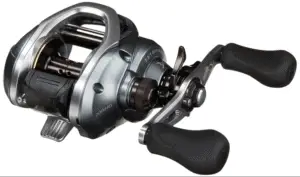
Reel – Having the correct reel to match with your rod is just as important. A good reel should be light and have a buttery smooth drag. There are several great reels on the market, but I recommend the a quality Shimano baitcasting reel. It’s a great reel packed with great features. So much so that it could easily be priced in the mid $200 range.
>>How To Choose A Great Bass Fishing Reel For The Money [and which to avoid at all costs]
Fishing Line
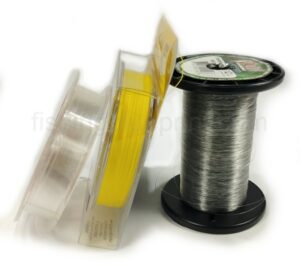
Fishing Line – Having a good line is just as important as having a good rod. I recommend fishing with a good fluorocarbon line. Furthermore, it’s super sensitive because it has little to no stretch, and underwater it’s invisible to the bass! If pride or money is on the line I would use Sunline Sniper FC.
>>21 Tips To Choose The Best Fishing Line
Fishing Lures & Baits

Fishing Lures – It’s pretty hard and darn near impossible trying to catch a fish without using some sort of lure or bait. More importantly these baits you should never forget at home or it could lead to a horrible day on the water
>>5 Bass Fishing Lures You Never Want to Leave At Home
Fish Finder
Finding lunker bass has never been easier when using a fish finding sonar unit. Packed with additional features to make your day on the water even easier. Maps that can plan your day or help you find your way back even in the darkest of nights. Bright bold numbers and letters to make reading the maps easy even in the brightest of days, and colors that pop and make it quick and easy to identify fish.
If you have a boat, kayak, canoe, or float tube, you need a fish finder.
Here’s our choice for the best fish finder between $299-$800:
Humminbird HELIX 7 CHIRP MEGA SI
It has all the features for any serious fisherman whether you’re an avid weekend warrior, or a tournament angler. This has all the bells and whistles you’re looking for.
>> Click HERE to Read The Reviews About Humminbird HELIX 7 CHIRP MEGA SI now
Here’s our choice for the best economic fish finder:
Garmin Stryker
While others look for bites, your fishfinder and GPS plotter help you reach your daily limit. You can mark preferred docks, ramps, and hotspots to easily return to them later and even share waypoints.
Click HERE to Read The Reviews About Garmin Stryker now!
Life Vest
According to Statista, “In the United States, 658 people died as a result of boating accidents and 2,641 people were injured in 2021.”
And it gets even worse… The National Safe Boating Council reported, “Where cause of death was known, 81% of fatal boating accident victims drowned.”
And if that’s not enough the incidence of deaths has climbed dramatically in recent years.
So if you’re on the water you NEED to wear your life vest. Protect you, your friends, and your families lives by wearing a life vest every time you’re on the water.
I recommend the ONYX PFD. It’s comfortable for all day use and there is lots of room for the air to move around so you won’t get sweaty.
>>Click HERE to read all the reviews actual customers!
Sunglasses
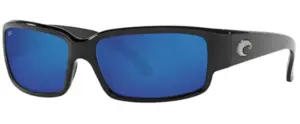 Sunglasses – Do you find yourself fishing in variable light and water conditions? Fishing in open water? Fishing in the bright hot sun? Then, only to leave the lake with eye strain and a splitting headache?
Sunglasses – Do you find yourself fishing in variable light and water conditions? Fishing in open water? Fishing in the bright hot sun? Then, only to leave the lake with eye strain and a splitting headache?
If so, I strongly recommend investing in a pair of Costa Sun Glasses. Thousands of anglers, charter guides, and tournament professionals put their trust into Costa, and so should you. Here’s why…
Costa’s co-injected bio-based nylon frame material is robust and durable, as well as extremely comfortable to wear for all-day use. TR-90 nylon is an excellent material for sports and performance frames since it is heat and cold-resistant.
Costa builds their glasses with class-leading technology. Their 580G glass lens sets them apart from the competition. These lenses are ideal for long days on the lake or sea since you won’t have to worry about scratches on the lens when you wipe the saltwater off. Needless to say they’re Costa’s most durable lenses.
Anyone who spends time outside, especially on the lake, needs polarized lenses. However, not all polarized sunglasses are the same. Costa is 99.9% polarized, giving it the most effective possible in blocking reflecting glare, and minimizing eye strain and headaches.
>>Click HERE to Read The Reviews On These Costa Sunglasses Right Now!
Drift Sock
Simply speaking, a drift sock (also known as a drift anchor) is like a parachute for the water. It gives you the ability to silently troll without spooking the fish!
Anyone who fishes out of a boat, canoe, kayak, stand up paddle board, or any other type of floating vessel should have a drift sock ready to use.
In addition to helping you catch more fish, recreational boaters also like to have 1-2 drift socks handy, just in case their motor goes out on them the drift sock will help slow their drift. This could be instrumental to allow rescuers to find that boat quickly and easily.
I strongly recommend the Drift Master Drift Sock by Mythik Outdoors.
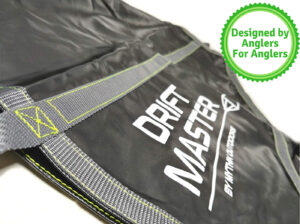 The construction is solid. Holding this in your hands gives you the peace of mind this feels durable and dependable.
The construction is solid. Holding this in your hands gives you the peace of mind this feels durable and dependable.
I love that it’s made from the gorilla-strong “RipStop” high density material, and I like that it’s even paired with the high-density nylon strapping.
It’s 30% stronger than other competitors who use a cheaper version of the RipStop material, so you never have to worry about his ripping.
Looking closely I can see they even triple stitched the high-tension points which is a good feature.
But best part… the Drift Master comes in a complete kit!
So get yours today and don’t leave yourself adrift.
The last thing to note is the Mythik Outdoors Drift Master drift sock kits sell out fast, so make sure you get yours before they’re gone!
>>Click HERE to Read The Reviews On This Drift Sock Today!
Landing Net
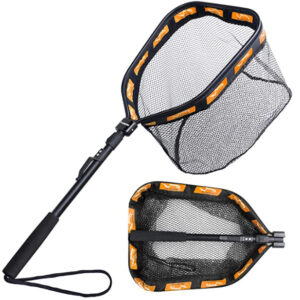 Landing Net – As you are reeling in that monster fish, you don’t want to injure yourself or knock the fish off the hook by trying to grab it.
Landing Net – As you are reeling in that monster fish, you don’t want to injure yourself or knock the fish off the hook by trying to grab it.
The PLUSINNO floating landing net is designed with foam padding on the hoop and provides buoyancy for fishermen. Now, If the net is dropped or blown overboard, the floating design makes it simple to retrieve – so you won’t have to be concerned about losing it! The rubberized net cannot be snagged. It keeps the fish safe for catch-and-release, and the non-absorbent covering avoids waterlogging and odor absorption in the net. It’s collapsing design allows for easy storage.
That’s why I recommend a dependable telescopic landing net.
>>Click HERE to Read The Reviews On This Floating Landing Net Today!
Fishing Weight Scale & Culler
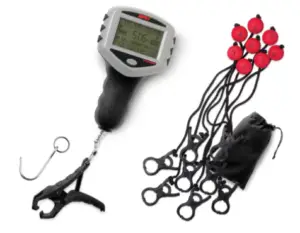 Fishing Weight Scale – Whether you’re going to keep your catch or just take a photo of it and brag to your friends it’s important to have an accurate scale. The Rapala Tournament Model Touch Screen Scale makes weighing and logging your catch easier and more convenient. The large digital scale has a lot of functions and is easy to use. simply keep track of your current catch and its place in your overall weight. To see the weight, just suspend the catch from the heavy-duty composite clamp or the accompanying stainless steel hook. Adding the important details to your catch couldn’t be easier – simply input your catch’s weight and tap on one of the eight storage places. The culling process makes it simple to identify fish that should be released for the greatest overall weight.
Fishing Weight Scale – Whether you’re going to keep your catch or just take a photo of it and brag to your friends it’s important to have an accurate scale. The Rapala Tournament Model Touch Screen Scale makes weighing and logging your catch easier and more convenient. The large digital scale has a lot of functions and is easy to use. simply keep track of your current catch and its place in your overall weight. To see the weight, just suspend the catch from the heavy-duty composite clamp or the accompanying stainless steel hook. Adding the important details to your catch couldn’t be easier – simply input your catch’s weight and tap on one of the eight storage places. The culling process makes it simple to identify fish that should be released for the greatest overall weight.
I recommend a Rapala Tournament Scale that has a large LED display like this one fishing scale here.
>>Click HERE to Read The Reviews on This Tournament-Grade Fishing Scale & Culling System now!
George Servinson
My name is George and I'm been fishing my entire life and love all things outdoors. My passion is helping anyone catch more fish. The newest things I've been doing lately is learning how to break down and clean all my reels, teaching my boy how to kayak fish, and bushcraft wilderness survival.


